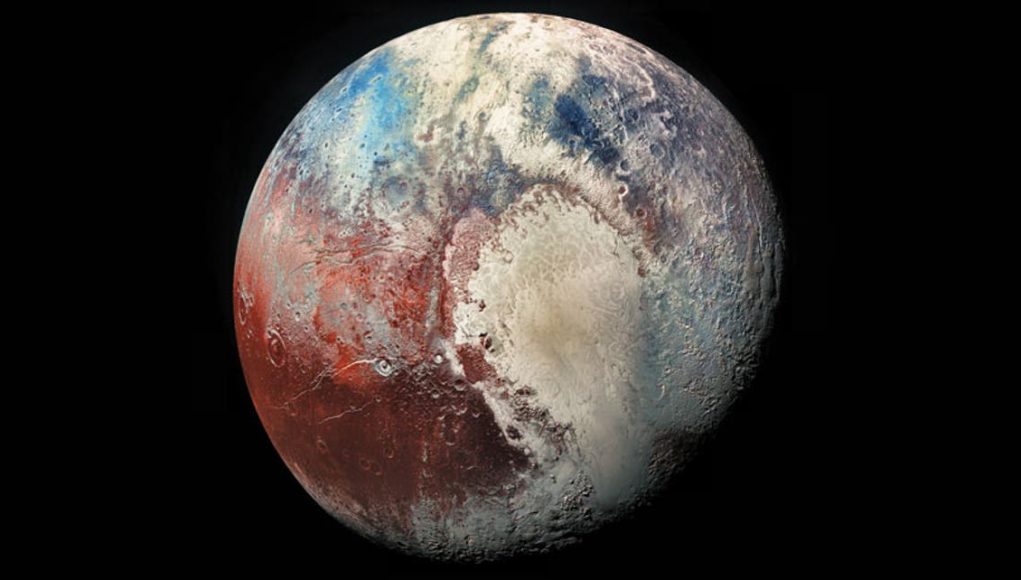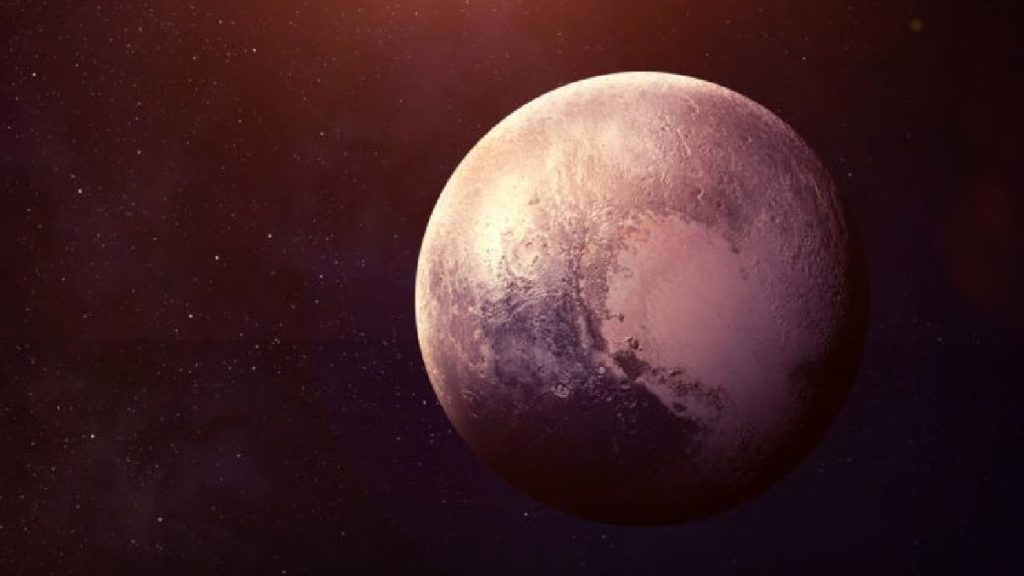
Discovery
It was discovered in 1930, by the American astronomer Clyde Tombaugh.
The discovery of Pluto is related to the phenomenon observed during the discovery of Neptune, consisting in the deviations in the motion of the planet, the source of which could not be the planet itself. During the discovery of the blue planet, it was observed that the motion of Neptune itself also showed some disturbances. For this reason, scientists began to consider whether it might not be related to the existence of another planet in the solar system beyond Neptune.
The name
Pluto is named after the Roman god of the underworld.
Pluto is the only planet (so far) named by an 11-year-old girl. In 1930, little girl named Venetia Burney of Oxford, England, suggested to her grandfather that the new discovery be named for the Roman god of the underworld. He forwarded the name to the Lowell Observatory and it was selected.
Planet status
On August 24, 2006, by the decision of the International Astronomical Union, taken in Prague, Pluto was deprived of the status of a planet and was included in the group of a new class of objects – dwarf planets
Pluto is one third water
This is in the form of water ice which is more than 3 times as much water as in all the Earth’s oceans, the remaining two thirds are rock. Pluto’s surface is covered with ices, and has several mountain ranges, light and dark regions, and a scattering of craters.
The First Visit
The first spacecraft will visit Pluto in July 2015. The New Horizons mission, launched in 2006 did a Pluto flyby on July 14th, 2015, on its way to the distant Kuiper Belt after almost a decade of flight.
**INTERETING FACTS**
- Discovered in 1930, Pluto is the second dwarf planet closest to the Sun and was once classified as the ninth planet.
- Pluto has 5 known moons. In order of distance from Pluto, they are Charon, Styx, Nix, Kerberos, and Hydra. Charon is the largest of the moons and is interconnected with Pluto.
- Charon is the largest of Pluto’s moons, related to the dwarf planet itself. Sometimes there is a phenomenon of the visual joining of these two objects.
- Pluto is smaller than Earth’s Moon, but larger than previously thought. Pluto’s diameter is 1,473 miles, according to recent measurements, while Earth’s Moon is 2,160 miles.
- It takes about five hours for sunlight to reach Pluto. It takes eight minutes to reach Earth.
- Charon is also so large that Pluto-Charon is sometimes considered a binary object, a double dwarf planet.
- Pluto has an extremely elliptical orbit that is not in the same plane as the eight official planets’ orbits.
- The dog Pluto made his debut the same year the former planet was discovered, but contrary to popular belief, the dog was named Pluto the planet, not the other way around. Disney animators speculated that Walt Disney chose the name to take advantage of the media hype surrounding the new planet.
- On July 17, 2015, the NASA New Horizons space probe approached Pluto, and for the first time since its discovery in 1930, we were able to see this little ice world up close.
- Sunlight on Pluto has the same intensity as moonlight on Earth. This is because it located so far from the Sun in the outer solar system – approximately 5,945,900,000 km.
- Since the early 1990s, its status as a planet has been questioned following the discovery of other objects of similar size. Following Eris’s discovery in 2005, Pluto was relegated from a planet to a dwarf planet in 2006.
- Attempting to view Pluto from Earth is like trying to see a walnut from 30 miles away
- Pluto was discovered on February 18, 1930 by Clyde Tombaugh of the Lowell Observatory.
- Pluto is 18.5% the size of the Earth.
- Disney’s Pluto the dog was named after the former planet. Disney’s Pluto the dog debuted in the same year the former planet was discovered, but contrary to popular belief, the dog was named after Pluto the (ex)-planet, not vice versa. Disney animators speculated that Walt Disney chose the name to capitalize on the hubbub surrounding the new planet.
- Pluto spins in the opposite direction to the Earth, which means that the sun rises in the west and sets in the east. Only Venus, Uranus, and Pluto have reverse rotation.
- One day on Pluto takes about 153 hours, and the entire journey around the Sun takes about 248 years. Its moon Charon also orbits Pluto for approximately 153 hours.
- In 2006, Pluto was reclassified to a dwarf planet, a change that is commonly considered a degradation. The issue of the status of the planet of Pluto has aroused controversy and debate in the scientific community and since then also among the general public.
- The name comes from the Roman god of the underworld, the equivalent of Hades in Greek mythology.
- Pluto takes 6 days, 9 hours, and 17 minutes to turn once, making it the second-slowest planet in the solar system. Venus has the slowest rotation and only takes 243 days to rotate once. Jupiter is the fastest rotating planet, rotating on average once every less than 10 hours.
- New Horizons, the first ship dedicated to studying Pluto’s environment, is the size of a piano. The New Horizons probe cost $ 700 million.
- Pluto is mainly made of ice and rock. Pluto has a heart shape on its surface. Images released on Tuesday by NASA show a heart shape that measures approximately 1,000 miles across. As NASA reports, “much of the heart’s interior appears remarkably featureless–possibly a sign of ongoing geologic processes.”
- It orbits the Sun in 248 Earth years.
- The temperature ranges from -226 to -240 degrees Celsius.
- New Horizons has revealed various surface features, including mountains that reach up to 3,500 meters. While methane and nitrogen ice cover a large portion of Pluto’s surface, these materials are not strong enough to hold such enormous peaks, so scientists suspect that these mountains are formed on a substrate of water ice.
- When Pluto is at its closest to the sun, Pluto’s atmosphere is a gas. When Pluto is at (farthest from the Sun, its atmosphere freezes and it snows there.
- Images posted on Tuesday by NASA show a heart shape that measures approximately 1,000 miles. As reported by NASA, much of the heart’s interior appears to be featureless – possibly a sign of ongoing geological processes.
- Pluto rotates on its side, which means is has extreme seasonal variation. At its solstices, a quarter of its surface is in permanent daylight, while another quarter is in permanent darkness.
- Sunlight is almost 2,000 times dimmer on Pluto than it is on Earth, and the sun would be only a small point in the sky. The sun would be 1/30 as big and 1/900 as bright as it is on Earth, though it would still be much brighter than a full moon.[
- Pluto is the only known dwarf planet with an atmosphere. It is very thin and would be toxic for humans to breathe. When Pluto is at its perihelion (closest to the sun), Pluto’s atmosphere is gas. When Pluto is at its aphelion (farthest from the sun), its atmosphere freezes and falls like snow.
- It takes Pluto 6 days, 9 hours, and 17 minutes to spin once, making it the planet with the second-slowest rotation in the solar system. Venus has the slowest rotation, taking 243 days to spin just once. Jupiter is the fastest-spinning planet, rotating on average once in just less than 10 hours.
- Due to its orbit, Pluto periodically approaches the Sun more than Neptune.
- The Hubble Space Telescope has also revealed evidence that Pluto’s crust may contain complex organic molecules.
- It takes about five hours for sunlight to reach Pluto. It takes eight minutes to reach Earth.
- In astrology, Pluto is associated with powers of creation/rebirth as well as destruction/death.
- A person who weighs 100 lbs. on Earth would weigh the least on Pluto than on any other planet, at 6.7 lbs. on Pluto. A person would weigh the most on Jupiter. A 100 lb. person on Earth would weigh 236.4 lbs. on Jupiter.
- The sky is so dark on Pluto that a person would be able to see stars during the day.
- Because Pluto’s moon Charon and Pluto orbit each other, Charon appears to stand still in Pluto’s sky. Additionally, the same sides of Pluto and Charon always face each other.
- The dwarf planet Pluto is named for the ancient Roman god of the underworld. In Roman mythology, Pluto was the son of Saturn who, with his three brothers, controlled the world: Jupiter controlled the sky, Neptune controlled the sea, and Pluto ruled the underworld
- Pluto is the only known dwarf planet with an atmosphere. It is very thin and toxic to humans.
- Pluto was classified as a planet for 75 years. It held the title of the ninth planet of the Solar System.
- Pluto is primarily made out of ice and rock. It is relatively small even when compared to Earth’s Moon, being one-sixth of the moon’s mass, and one-third of its volume.
- Pluto has an unusual orbit that takes it closer to the Sun than the farthest planet Neptune, but also, it takes it farther from the Sun than Neptune’s position.
- Pluto has a radius of 1.185 kilometers / 737 miles; thus, it is 1/6 the width of Earth and a diameter of 2.326 km / 1.445 mi.
- Pluto has mountains, valleys, and craters. The surface temperatures vary from -375 to – 400 degrees Fahrenheit / – 226 to – 240 degrees Celsius.
- The official symbol for Pluto are the interlocking letters of P and L, which not only stand for the first two letters of the planet but also are the initials of Percival Lowell, the American astronomer who initiated the search for a planet beyond Neptune that resulted in the discovery of Pluto. The Lowell Observatory in Arizona is named after him.
- On Pluto, the sun rises and sets about once a week.
- Pluto is one third made out of water. Its atmosphere is remarkably similar to that of a comet since it collapses as it moves away from the Sun and expands as it gets close.
- Pluto does not seem to have a magnetic field.
- At its warmest, Pluto can reach temperatures of minus 369 degrees Fahrenheit (minus 223 degrees Celsius) . At its coldest, temperatures are minus 387 degrees F (minus 233 C).
- In 1941, the newly created element plutonium was named after Pluto
- Pluto’s distance from Earth varies. At its closest, Pluto is 4.2 billion kilometers (2.6 billion miles) away. At its farthest, Pluto is about 7.5 billion kilometers (4.7 billion miles) from Earth. It would take about 10 years for a spaceship to reach Pluto.
- Pluto is approximately 4.6 billion years old, about the same age as the rest of the solar system.
- New Horizons Spacecraft also showed that Pluto’s surface has mountains as tall as 11,000 ft/3,500 m which are close to the size of Earth’s Rocky Mountains.
- Of all of the planets in our solar system that have been the topic of controversy and debate, Pluto is at the top of the list. Generations grew up thinking that Pluto was the ninth planet and then in 2006, they demoted little Pluto to become a dwarf planet.
- At one time, Pluto was not just thought to be our ninth planet but was also thought to be the largest item in the Kuiper Belt which is located in the areas beyond Neptune’s orbit.
- It was so far out that even the most powerful telescopes of the time could only show Pluto as a fuzzy grey image.
- The demotion of Pluto outraged many in the scientific community as well as public opinion. There was a proposal of a new definition of “planethood” in 2017 that included scientists and members of the New Horizon spacecraft mission to include “round objects in space smaller than stars” as part of the classification criteria. This would change the number of planets in our solar system from the current eight to around one hundred.
- Pluto is smaller than our moon and is a mysterious world that has valleys, plains, craters, and possibly glaciers. It has five moons, and the biggest moon is Charon, which is almost half the size of Pluto.
- Charon and Pluto are listed as a “double planet” because they orbit so close to each other. Charon is listed as the largest satellite relative to its parent planet in our solar system.
- It is thanks to the New Horizon spacecraft that we have learned so much about Pluto and its complex geology.
- In 1905, Percival Lowell, an American astronomer first discovered Pluto when he found strange deviations in the orbits of both Uranus and Neptune. These alterations in their orbits suggested that there was another object’s gravity that was tugging on them.
- Lowell predicted that there was a mysterious planet in 1915 but he passed away before he could ever find it. In 1930, Clyde Tombaugh at the Lowell Observatory officially discovered Pluto based on the information from Lowell and other astronomers.
- Tombaugh was actually looking for the mysterious “Planet X” and instead discovered Pluto. It was revealed later that Planet X did not exist.
- Discovery photographs of Pluto
- Pluto was named by an 11-year-old from Oxford, England named Venetia Burney. She had suggested to her grandfather that the new discovery be named after the mythological Roman god of the underworld.
- Her grandfather gave the suggestion to the Lowell Observatory where they acknowledged the new name, which coincidentally has the first two letters of Percival Lowell’s name.
- In preparation for the New Horizons space mission, scientists used the Hubble Space Telescope to photograph Pluto in 2005. In the process, they discovered two other small moons orbiting around Pluto, now named Nix and Hydra.
- These two moons are 2-3 times farther away from Pluto than the moon Charon. The New Horizons spacecraft measured Nix at 26 mi/42 km long and 22 mi/36 km wide, and Hydra at 34 mi/55 km long and 22 mi/36 km wide.
- The data suggested that the surface of Hydra is probably covered in water ice. In 2011, the Hubble Space Telescope discovered a fourth moon orbiting around Pluto, now named Kerberos.
- It is estimate that it is 8-21 mi/13-34 km in diameter. In 2012, the fifth moon of Styx was discovered, and it is estimated to be 6 mi/10 km wide. All four of the new moons have highly chaotic orbits.
- The discovery of the four additional moons acted as ammunition for those that wanted Pluto’s status to be a planet.
- Formation:
- Pluto is part of the Kuiper Belt which are objects beyond Neptune’s orbit and are believed to have been formed 4.5 billion years ago as our solar system formed.
- The objects in this disc-like zone are rocky and icy and are referred to as Kuiper Belt objects, plutoids, or trans Neptunian objects.
- The most popular theory about the formation of the moon Charon and Pluto is that Pluto was hit by another object that was around its size.
- Most of the material gathered to form the Pluto that we see today, and the rest was spun off and then came together to become Charon.
- Pluto has a radius of 715 mi/1,151 km. and is around one sixth the width of our Earth. To give you a comparison, if Earth were the size of a nickel, Pluto would be the size of a kernel of popcorn.
- Pluto is incredibly far away. Astronomers use the measurement of “AU” (astronomical unit) to list distances for objects in space.
- One AU is the distance from the Earth to the sun. Pluto is 39 AU’s from the sun, and it takes sunlight 5.5 hours to travel to Pluto.
- Pluto has five moons: Charon, Styx, Nix, Kerberos, and Hydra. Charon is the closest to Pluto and the largest of all of the moons, and Hydra is the farthest away. The discovery of Charon in 1978 also showed astronomers that this moon was almost half the size of Pluto.
- It was named Charon after the mythological character that took souls to the underworld on a ferry. The close proximity of Pluto and Charon make them a “binary planet” which is unlike any other planet in our solar system.
- They orbit remarkably close to each other, both being tidally locked so that only one side faces the other one. Charon and Pluto are only 12,200 mi/19,640 km apart from each other, which is the distance between Sydney, Australia and London, England.
- Charon is a gray-tone in color and Pluto has a reddish tint. It is thought that early in its history, Charon might have had a subsurface ocean, although there is no evidence of one today and it more than likely could not support one. Both Pluto and Charon are tipped on their side in relation to the sun.
- The New Horizon spacecraft observations have shown that there are canyons on Charon’s surface, some plunging as deep as 6 mi/9.7 km.
- It also has a large area of troughs and cliffs that stretch for 600 mi/970 km around the center section of the moon. One area of Charon has darker material that is similar to some of Pluto’s regions
- Surface and Structure:
- Until the 2015 New Horizons spacecraft visited Pluto, scientists new extraordinarily little about it. Even some of the images taken by high-powered telescopes showed a grey fuzzy blob.
- New Horizons revealed that Pluto has a diameter of 1,473 mi/2,370 km and it is only around 2/3 the size of our moon.
- New Horizons also showed that Pluto’s surface has mountains as tall as 11,000 ft/3,500 m which are close to the size of Earth’s Rocky Mountains.
- Methane and nitrogen ice cover a majority of Pluto’s surface, neither of these materials have the strength to support such high mountainous peaks. Scientists believe that the mountains were formed on a water ice bedrock.






















